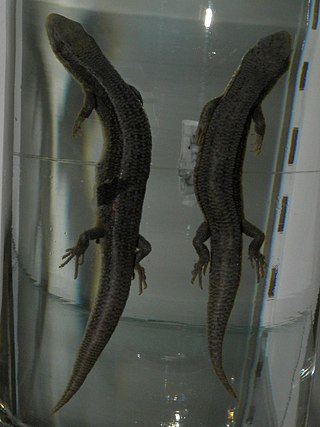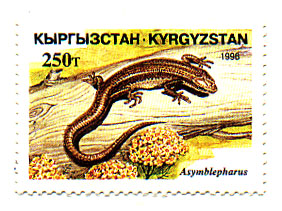
Ablepharus is a genus of skinks that contains the common snake-eyed skinks. Both their scientific and common names refer to the fact that their eyelids have fused to a translucent capsule; as in snakes, they thus are physically incapable of blinking. They are small lizards and prefer to live in the leaf litter of dry fields and hills. Their scales give them a very shiny, bronze appearance with a characteristically dark stripe down the sides of their bodies. They prey on small insects and other small mollusks.
The minor snake-eyed skink is a species of lizard in the family Scincidae. The species is native to Asia.
Ablepharus tragbulensis is a species of skink endemic to South Asia.

The two-lined ground skink is a species of skink. It is found in the Nilgiri Hills and Travancore Hills of India.

Kaestlea travancorica, also known as the Travancore ground skink or Barbour's ground skink, is a species of skink endemic to southern Western Ghats.

Ablepharus kitaibelii, commonly known as the European copper skink, European snake-eyed skink, juniper skink, or snake-eyed skink, is a species of skink, a lizard in the family Scincidae. The species is endemic to Eastern Europe and Southwestern Asia.
Ablepharus sikimmensis is a species of skink found in Bangladesh (Rangpur), Bhutan, China (Tibet), India and Nepal.

Ablepharus budaki, commonly known as Budak's skink and Budak's snake-eyed skink, is a species of lizard in the family Scincidae. The species is endemic to the Near East.

Ablepharus rueppellii, known commonly as Rüppell's snake-eyed skink, is a species of skink found in the Middle East. It was formerly considered a subspecies of Ablepharus kitaibelii, but has since been distinguished. What is currently recognized as this species is possibly two distinct species.

Chernov's skink is a species of skink, a lizard in the family Scincidae. The species is endemic to northern Eurasia.
Ablepharus darvazi, also known as Darvaz snake-eyed skink, is a species of skink, a lizard in the family Scincidae. The species is endemic to Central Asia.

The desert lidless skink is a species of skink native to southern Kazakhstan, Kyrgyzstan, northern Tajikistan, Uzbekistan and eastern Turkmenistan.
Ablepharus lindbergi, Lindberg's snake-eyed skink or Lindberg's twin-striped skink, is a species of lizard in the family Scincidae. It is endemic to Afghanistan.
Proablepharus tenuis, also known commonly as Broom's small skink and the northern soil-crevice skink, is a species of skink, a lizard in the family Scincidae. The species is endemic to Australia.

Ablepharus alaicus is a species of skink found in China, Kyrgyzstan, Uzbekistan, Tajikistan, and Kazakhstan.

Ablepharus eremchenkoi is a species of skink, a lizard in the family Scincidae. The species is native to Kazakhstan and Kyrgyzstan.

The Himalaya ground skink is a species of skink found in Pakistan, India, Nepal, and Turkmenistan.
The Mahabharat ground skink is a species of skink found in Nepal.
The Nepal ground skink is a species of skink found in Nepal.










